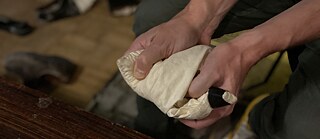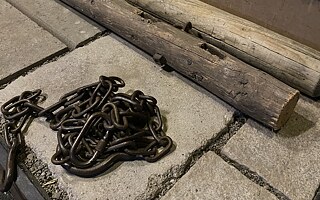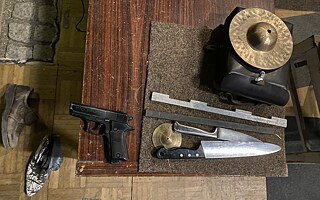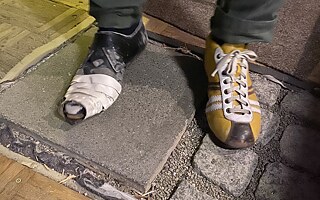Foley Artist
The Art of Sounds

Creaking doors, singing swords and the crunch of snow underfoot – sounds bring stories to life. In this interview, foley artist Max Bauer talks about his job, explaining how he fires the imagination of listeners, and gives them goose bumps.
By Marta Krus
Max Bauer, what does your job actually sound like?
Max Bauer: My job sounds very diverse. I do everything they request for audio plays and also films, which means everything that can make a sound. My job sounds like the whole world sounds, and sometimes even a bit more. Sometimes I get to invent things that aren’t real, for instance how a bad dream might sound.
Do we still need sound effects artists these days, in an era of extensive digital sound archives?
I often get asked that. Put it like this: theoretically sound effects artists are unnecessary, because every sound already exists and they can be altered. But with that approach it will never be quite right. If a sword falls to the ground in a radio play and the director says: the sword needs to sound as if someone could be killed with it at any moment – or, it has to sound as though no one could hurt a fly with it – that might be even more difficult, because then you need a sound effects artist to throw the sword down.
How do you become a foley artist?
The most common route is via a university degree or a career in sound design. In my day, in other words 30 years ago, the sound effects profession was still taught solely through a teacher-student relationship. I was trained by a master, and I was his apprentice for three years. We used to sit side-by-side and we’d often be grafting away on a film or radio play sequence at the same time.
Variété artists who used sound effects to add sound to the image were in fact the first foley artists.
What’s the historical background of your profession?
Jack Donovan Foley was the first to professionalise image-synchronised sound recording and become a specialist in the field, and he was one of the first sound effects artists in Hollywood. That’s why the profession is also known as foley artist today. That was in 1929. In America the first film sound recording attempts date back to the 1890s, and in Germany at that time they already had people who performed on stage as variety artists or supporting acts, creating sound effects to add a soundtrack to the picture. They were essentially the first sound effect artists. They used to call them sound imitators in those days. In America they were known as effect boys, because they produced sound effects to go with the moving picture.
How did they make the sounds in audio plays back then?
For a long time they have tried to get protagonists to create all their own noises on the radio. There’s a famous radio play, I think it was by Arnolt Bronnen, a dramatist and radio drama director in the 1920s and 1930s, which was a remake of Wallenstein's Camp as a radio play. The actors played their roles in full costume to ensure sound authenticity. These days, sound effects artists would perform these special sounds, not the actors. In fact it has not become as well established or meaningful as an art in radio as in the motion picture.
How did the art develop in the context of radio and audio drama?
Radio or audio drama developed into an art medium very fast at an early stage. It started in the 1950s, when they worked with suspenseful music, sound design, exciting editing techniques and jump cuts, as well as alienation effects. These things are still done today. It’s a lot of fun from an artistic perspective, but it offers more scope for music, composition and sound design than for creating sound effects as such.
Radio plays in which someone for instance comes through the door, the door opens and closes, and you hear a “clack-clack” sound – that sort of thing hasn’t been around at all for a while now. There was a phase where I had the feeling they no longer needed the sound effects profession for radio at all. But now audio plays are starting to be more focused on social drama, rather than post-dramatic, performative and sound-design-oriented. It’s more about realism and exaggeration. So the art has become fun again, and is needed.
For me, audio drama is the supreme discipline of sound effects
What’s the biggest challenge in your work?
I collaborated with an author and audio dramatist from Vienna on a very exciting radio play that was created in Germany in coproduction with Hessischer Rundfunk. We were looking at a very abstract situation in a part of the script spoken by someone who was stacking up body parts while they spoke. It was very abstract in terms of both the art and the text. I had to communicate the idea that the radio play was about a massacre so that the listener could feel and understand this, as well as the question of why things like this happen and where it’s coming from and heading in a sound sense. That was a great challenge. To achieve this, you need an experienced foley artist, because it poses the question: what’s the difference between zombies and realism?
For me, audio drama is the supreme discipline of sound effects, because you have to tell stories that aren’t backed up by images. The foley artist has to be very accurate and precise. It’s easy to trick the eye and ear together, but the ear is far more accurate on its own and isn’t so easy to deceive.
We already know a lot about that from our own life experience. For some people the squeal of chalk on a board is bad. There are sounds that make people uneasy, cause goosebumps or terrify. That’s where psychoacoustics comes in. In the deep bass range there’s a really low sound that makes a situation eerie and threatening. I like doing it in the theatre, where the people watching the performance are unsure “can I hear something or not?” But something’s happening to the listeners’ perception. Although I do try to avoid sounds and frequencies that cause pain in my work, because I don’t want to put them off listening.
What’s the secret of a good foley artist?
A foley artist has to feel the story or the character and understand it in terms of content, but also from a psychological perspective. That’s the most important thing for me. I often feel like an actor. I immerse myself in the role, try to understand it and then move like that character. I fight like them and draw my weapon like them. It’s actually acting, and it’s also a psychological game. I think that’s the supreme art of sound effects.
In the interview (in German), Max Bauer shares some tricks he uses to create sounds. Crunch of snow underfoot, for example, can be made using starch filled cloth bags that are kneaded.


